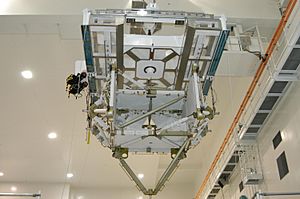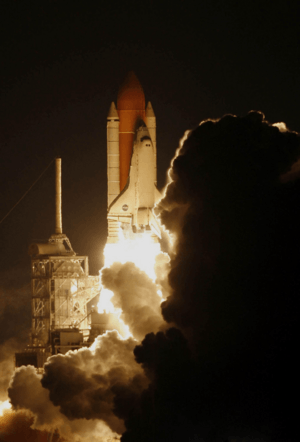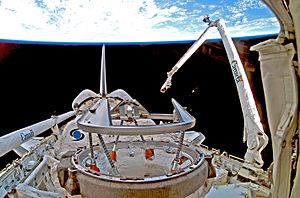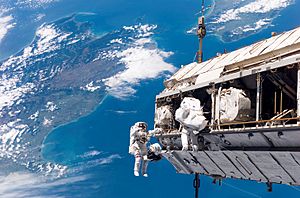STS-116 facts for kids

Discovery rollout
|
|
| Mission type | ISS assembly |
|---|---|
| Operator | NASA |
| Mission duration | 12 days, 20 hours, 44 minutes, 16 seconds |
| Distance travelled | 8,500,000 kilometres (5,300,000 mi) |
| Spacecraft properties | |
| Spacecraft | Space Shuttle Discovery |
| Launch mass | 120,413 kilograms (265,466 lb) |
| Landing mass | 102,220 kilograms (225,350 lb) |
| Crew | |
| Crew size | 7 |
| Members |
|
| Launching | |
| Landing | |
| Start of mission | |
| Launch date | 10 December 2006, 01:47:35 UTC |
| Launch site | Kennedy LC-39B |
| End of mission | |
| Landing date | 22 December 2006, 22:32:00 UTC |
| Landing site | Kennedy SLF Runway 15 |
| Orbital parameters | |
| Reference system | Geocentric |
| Regime | Low Earth |
| Perigee | 326 |
| Apogee | 358 |
| Inclination | 51.6 degrees |
| Period | 91.37 minutes |
| Epoch | 12 December 2006 |
| Docking with ISS | |
| Docking port | PMA-2 (Destiny forward) |
| Docking date | 11 December 2006, 22:12 UTC |
| Undocking date | 19 December 2006, 22:10 UTC |
| Time docked | 7 days, 23 hours, 58 minutes |
  Back (L-R): Curbeam, Patrick, Williams, Fuglesang Front (L-R): Oefelein, Higginbotham, Polansky |
|
STS-116 was a space mission by the Space Shuttle Discovery to the International Space Station (ISS). Discovery launched on December 9, 2006, at 8:47:35 PM EST. This was the first time a Space Shuttle had launched at night since 2002.
The main goals of the mission were to deliver and attach a new part, called the P5 truss, to the International Space Station. The crew also worked to rewire the station's power system and exchange some of the astronauts living on the ISS. The shuttle landed on December 22, 2006, at the Kennedy Space Center. This mission was special for Sweden because it was the first time a Scandinavian astronaut, Christer Fuglesang, flew into space.
STS-116 was the last time a Space Shuttle was planned to launch from Pad 39B. This launchpad was later changed to be used for other rockets.
Contents
- Meet the Crew of STS-116
- Key Achievements of the Mission
- What the Mission Carried
- Preparing for Launch
- Mission Diary
- December 7 (First Launch Attempt)
- December 9 (Flight Day 1 – Launch)
- December 10 (Flight Day 2)
- December 11 (Flight Day 3 – Docking to ISS)
- December 12 (Flight Day 4 – Spacewalk 1)
- December 13 (Flight Day 5 – Solar Array Work)
- December 14 (Flight Day 6 – Spacewalk 2)
- December 15 (Flight Day 7)
- December 16 (Flight Day 8 – Spacewalk 3)
- December 17 (Flight Day 9)
- December 18 (Flight Day 10 – Spacewalk 4)
- December 19 (Flight Day 11 – Undocking)
- December 20 (Flight Day 12)
- December 21 (Flight Day 13)
- December 22 (Flight Day 14 – Landing)
- Backup Plans for Space Shuttle Missions
- Wake-Up Songs in Space
- Images for kids
- See also
Meet the Crew of STS-116
The STS-116 mission had a team of seven astronauts. They were responsible for flying the Space Shuttle Discovery and completing important tasks on the International Space Station.
| Position | Launching astronaut | Landing astronaut |
|---|---|---|
| Commander | Second flight spaceflight |
|
| Pilot | First and only flight spaceflight |
|
| Mission Specialist 1 | First flight spaceflight |
|
| Mission Specialist 2 | Third and last flight spaceflight |
|
| Mission Specialist 3 | First flight spaceflight |
|
| Mission Specialist 4 | First and only flight spaceflight |
|
| Mission Specialist 5 | Expedition 14 First flight spaceflight ISS Flight Engineer |
Expedition 14 Second and last flight spaceflight ISS Flight Engineer |
Key Achievements of the Mission

The STS-116 mission achieved several important goals for the International Space Station.
- The mission delivered and attached the P5 truss segment to the International Space Station. This was a crucial step in building the station.
- Astronaut Sunita Williams traveled to the station on this mission. She later set a record for the longest time a female astronaut spent in space.
- Astronaut Thomas Reiter returned to Earth on Discovery.
- Christer Fuglesang became the first astronaut from Sweden to fly in space. It was rare to have two astronauts from the ESA in space at the same time.
- The crew installed the third of three SPHERES testbeds on the ISS. These are small, free-flying robots used for experiments.
- Astronauts completed a major rewiring of the station's power system. This allowed the new solar arrays, installed by STS-115, to start working.
- More rewiring was done to prepare the station for the Station-Shuttle Power Transfer System (SSPTS). This system would let the shuttle get power from the ISS.
- One part of the original P6 solar array was folded up. This made space for the new P4 array to rotate and follow the sun.
- STS-116 was the last Space Shuttle mission planned to launch from Pad 39B. This pad was later changed for future rocket launches.
- Five of the seven crew members were flying in space for the first time. Only Commander Mark L. Polansky and Mission Specialist Robert Curbeam had flown before.
- Robert Curbeam was the first astronaut to do four spacewalks during one mission.
- This was the first mission with two African-American crew members.
Power System Upgrades for Discovery
After this mission, Discovery received important upgrades. Its old power converter units were replaced with new parts for the Station-Shuttle Power Transfer System (SSPTS).
These old units used to change the shuttle's power to match the station's power. But once the station had its own strong electrical systems, the shuttle's power was no longer needed by the ISS.
After STS-118, Discovery and Endeavour could get power from the ISS. This was a big deal because it meant they used less of their own fuel. Space Shuttle missions were limited by how much hydrogen and oxygen they could carry for power. By getting power from the ISS, Discovery and Endeavour could stay docked to the station for 2 to 4 extra days.
What the Mission Carried
The main cargo for the STS-116 mission was the P5 Truss segment. This part was added to the International Space Station.
The shuttle also carried a Spacehab Logistics Module. This module was used to bring supplies to the ISS. It also had an Integrated Cargo Carrier with four small satellites. These satellites were released after the shuttle left the ISS. They included:
- The ANDE (OSCAR 61 and 62), which was a technology test from the Naval Research Laboratory.
- Three CubeSats: RAFT-1 (OSCAR 60) and MARScom for the United States Naval Academy, and MEPSI 2A/2B for DARPA.
This was the first time a Space Shuttle had released satellites since 2002.
Preparing for Launch
STS-116 was originally planned to launch on December 14, 2006. However, NASA decided to try for an earlier launch date of December 7. The launch window, which is the time when a launch can happen, was from December 7 to December 17. The seven astronauts arrived at Kennedy Space Center on December 3, 2006.
The main items for the 13-day mission were the P5 truss segment, the SPACEHAB module, and an integrated cargo carrier. This mission was the 20th Space Shuttle flight to the station.
Launching on the earlier date meant it would be a night launch. After the Columbia accident, NASA had rules that shuttles had to launch during the day. This was so cameras could see any pieces falling off. But after improvements to the shuttle's fuel tank and new ways to check the shuttle in space, the daylight-launch rule was changed.
Discovery was moved to the Vehicle Assembly Building (VAB) on October 31. On November 1, it was lifted upright and connected to its external tank and solid rocket boosters. The shuttle was then moved to Launch Complex 39B on November 11.
The crew came back to Kennedy Space Center on November 13 for their final training. This included practicing emergency steps and a simulated countdown. The astronauts then returned to Houston and came back to Kennedy Space Center on December 3, just before the planned launch.
The mission's cargo, including the SPACEHAB module and the P5 truss, was loaded into Discovery's payload bay on November 16. After a final review, Discovery was cleared for flight, and the launch date was officially set for December 7, 2006.
Mission Diary
December 7 (First Launch Attempt)

The first launch attempt was set for December 7. However, thick clouds were expected over Florida. The astronauts boarded Discovery for the planned launch at 9:37 PM EST. Everyone hoped the clouds would clear, but they didn't. The launch was called off, and the next attempt was set for December 9, 2006. NASA had already decided not to try launching on December 8 because of a cold weather front.
| Attempt | Planned | Result | Turnaround | Reason | Decision point | Weather go (%) | Notes |
|---|---|---|---|---|---|---|---|
| 1 | 7 Dec 2006, 9:35:48 pm | Scrubbed | — | Weather | 30% | NASA opted for 48-hour turnaround instead of 24 due to 10% go weather forecast for 8 December 2006 | |
| 2 | 9 Dec 2006, 8:47:35 pm | Success | 1 day, 23 hours, 12 minutes | 70% |
December 9 (Flight Day 1 – Launch)
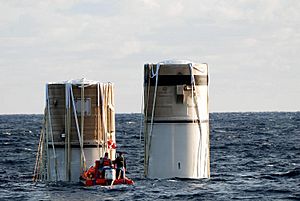
Discovery successfully lifted off at 8:47 PM EST (01:47 UTC). The launch lit up the Florida coastline. Weather conditions, especially crosswinds, improved just before launch. Fueling of Discovery's external tanks began at 12:46 PM EST and finished around 3:45 PM EST.
This was the third shuttle mission in five months. It was also the first night launch in four years and the last time a shuttle launched from LC-39B.
December 10 (Flight Day 2)
Flight day 2 started at 3:47 PM UTC. The first task was a detailed inspection of the shuttle. Astronaut Nicholas Patrick used sensors and cameras on a long boom and robotic arm to check the wings and nose. This process took over five hours. The crew also checked their spacesuits and got ready to dock with the International Space Station.
December 11 (Flight Day 3 – Docking to ISS)
Flight day 3 began at 3:18 PM UTC. Discovery docked with the International Space Station at 10:12 PM UTC. The hatch between the station and Discovery opened at 11:54 PM UTC. The combined crew then continued inspecting the shuttle. They also unloaded the P5 truss segment from the shuttle's cargo bay. The shuttle's robotic arm passed it to the station's arm. Astronauts Robert Curbeam and Christer Fuglesang prepared for their spacewalk by sleeping in the airlock. This helps their bodies adjust to lower pressure to avoid decompression sickness.
December 12 (Flight Day 4 – Spacewalk 1)
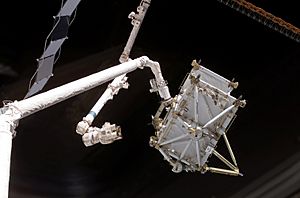
Flight day 4 started at 3:47 PM UTC. During the first spacewalk (EVA), astronauts Robert Curbeam and Christer Fuglesang added the P5 truss segment to the ISS.
The spacewalk began at 8:31 PM UTC. Curbeam and Fuglesang removed clamps from the P5 truss. Mission Specialist Joan Higginbotham used the station's robotic arm (Canadarm2) to move the truss close to its new spot. The spacewalkers then guided her to connect the truss.
After the P5 was attached, Curbeam and Fuglesang connected power, data, and heater cables. They also replaced a broken video camera on the S1 truss. They even finished some extra tasks because they were ahead of schedule.
At the end of the spacewalk, Curbeam congratulated the Nobel Prize winners. Christer Fuglesang gave a short speech in Swedish, encouraging people to become astronauts. The spacewalk ended at 3:07 AM UTC on December 13, lasting 6 hours and 36 minutes.
During the spacewalk, mission managers checked images of the shuttle's heat shield. They decided it was safe for return to Earth. They also canceled a more detailed inspection that was planned.
Three more spacewalks were needed to rewire the station's power. This would allow the solar arrays installed during STS-115 to be used. The first step was folding the port solar array on the P6 truss. This allowed the Solar Alpha Rotary Joint on the P4 to activate and rotate. This joint lets the P4 solar arrays track the sun.
The astronauts had to sleep in protected areas to avoid radiation from a solar flare.
December 13 (Flight Day 5 – Solar Array Work)
Flight day 5 began at 3:21 PM UTC. The main activity was trying to fold up the P6 port-side solar array. The process started at 6:28 PM UTC, but the array got "kinks" and "billows" and wouldn't fold correctly. Controllers then tried to extend and retract the array over 40 times to fix it.
At 12:50 AM UTC, they stopped trying to retract it for the day. The problem seemed to be a loss of tension in the guide wires. Only 14 of the 31 sections of the array had folded. But this was enough to safely activate the Solar Alpha Rotary Joint (SARJ) at 1:00 AM UTC. This allowed the solar arrays on the P3/P4 truss to rotate and follow the sun.
December 14 (Flight Day 6 – Spacewalk 2)
Flight day 6 began at 3:19 PM UTC. The main activity was Spacewalk No. 2. This spacewalk started the rewiring work to use the station's permanent electrical power systems. To do this, station controllers had to turn off about half of the ISS systems. The spacewalk began at 7:41 PM UTC with Bob Curbeam and Christer Fuglesang leaving the Quest airlock 30 minutes early. Spacewalk No. 2 was planned to activate channels 2 and 3 of the four-channel electrical system. The work went smoothly. About two hours into the spacewalk, power from the P4 solar arrays started flowing through the rewired system for the first time. The spacewalk finished in exactly 5 hours, at 12:41 AM UTC.
December 15 (Flight Day 7)
Flight day 7 was a lighter work day for the crews of Discovery and the ISS. Spacewalkers Bob Curbeam and Christer Fuglesang rested. The rest of the crew cleaned up and prepared for Spacewalk No. 3 on Flight day 8. The crews also took a group photo and held a joint news conference. During this event, Christer Fuglesang was interviewed by Crown Princess Victoria. He also set a 20-second Frisbee world record in space, which was shown live on Swedish TV.
To try and fix the stuck solar panel, Thomas Reiter exercised vigorously on a machine that can cause vibrations in the solar arrays. This did not work. Mission controllers kept looking for other ways to fully fold the solar panel, including possibly another spacewalk.
December 16 (Flight Day 8 – Spacewalk 3)
Flight day 8 began at 2:48 PM UTC. Astronauts Bob Curbeam and Suni Williams finished the rewiring work on the International Space Station. The spacewalk began at 7:25 PM UTC and went well. As an extra task, Curbeam and Williams also continued working on the sticking solar array. They managed to fold another six sections of the P6 array. At the end of the spacewalk, 11 sections, or 35%, were still unfolded. After the spacewalk, the astronauts returned to the ISS through the Quest airlock.
During the spacewalk, Suni Williams' digital camera was lost. It was thought that a tether got caught, causing the camera's release button to break. This made the camera fall out of its holder. The pictures on the camera were lost, but it was decided that new ones were not needed.
December 17 (Flight Day 9)
Flight day 9 was mostly spent getting ready for Spacewalk No. 4. The spacesuits were prepared, and the crew practiced the new steps for trying to fold the solar array. Various tools were covered in special tape to protect the array from sharp metal objects and to provide electrical safety.
December 18 (Flight Day 10 – Spacewalk 4)
Flight day 10 began at 2:17 PM UTC. Bob Curbeam and Christer Fuglesang went on an extra spacewalk at 5:12 PM UTC. Their goal was to fully close the last eleven sections of the stubborn P6-port Solar Array Wing. This quickly planned spacewalk was successfully completed after 6 hours and 38 minutes. At the end of Spacewalk No. 4, Curbeam ranked fifth in total spacewalk time for U.S. astronauts.
December 19 (Flight Day 11 – Undocking)
Flight day 11 began around 2:47 PM UTC. The Expedition 14 and STS-116 crews took photos together. Then, they closed the hatches between the ISS and Discovery. Undocking was completed at 10:10 PM UTC. Because the mission was extended for Spacewalk No. 4, Discovery did not fly a full circle around the ISS to film it. Instead, it flew only a quarter of the way around before leaving.
December 20 (Flight Day 12)
Flight day 12 began at 12:48 PM UTC. The astronauts spent the day checking Discovery's heat shield. They also prepared for landing on December 22 (Flight day 14). Because the mission was longer than planned, the shuttle had to try to land on flight day 14 unless all three landing sites were unsafe. Two satellites were also launched:
- MEPSI (Microelectromechanical System-Based PICOSAT Inspector) looks like two coffee cups tied together. It was tested to see if it could inspect damaged satellites.
- RAFT (Radar Fence Transponder) is made of two 5-inch cubes built by the U.S. Naval Academy. These tested space radar systems and acted as data relays for ground communications.
December 21 (Flight Day 13)
Flight day 13 began at 12:17 PM UTC. Discovery's crew launched the ANDE (Atmospheric Neutral Density Experiment) microsatellites for the Naval Research Laboratory. These satellites were designed to measure the density and makeup of the low Earth orbit atmosphere. This helps predict how objects move in orbit. One of the satellites did not come out of its launch container right away. However, ANDE is now sending data, and it came out of the container about 30 minutes after its launch.
December 22 (Flight Day 14 – Landing)
Flight day 14 began at 12:17 PM UTC. Preparations for landing were complete. Strong crosswinds prevented a landing at Edwards Air Force Base. Clouds and rain were a problem at Kennedy Space Center Shuttle Landing Facility for the first landing opportunity. This raised the chance of landing at White Sands Space Harbor. A landing at White Sands could have meant it would take up to 60 days to return the shuttle to Kennedy Space Center.
The first landing chance at Kennedy Space Center was canceled due to bad weather. However, at 9:00 PM UTC, new coordinates were sent to the shuttle to try landing at Kennedy on runway 15. The de-orbit burn for Kennedy happened at 9:27 PM UTC. Since the landing time was close to sunset, it was not considered a night landing. The special xenon runway lights were used. Discovery touched down 30 seconds earlier than expected. Landing time at Kennedy was 5:32 PM EST (10:32 PM UTC).
Backup Plans for Space Shuttle Missions
Sometimes, space missions need backup plans in case something goes wrong. These are called contingency missions.
STS-301 Rescue Mission
STS-301 was a special rescue mission. It would have launched if Space Shuttle Atlantis had been damaged during STS-115. It was a changed version of the STS-116 mission, with an earlier launch date. If needed, it would have launched no earlier than November 11, 2006. The crew for this rescue mission would have been a smaller group from the STS-116 crew:
- Mark L. Polansky – Commander and main robotic arm operator
- William Oefelein – Pilot and backup robotic arm operator
- Robert Curbeam – Mission Specialist 1, Spacewalker 1
- Nicholas Patrick – Mission Specialist 2, Spacewalker 2
STS-317 Rescue Mission
If Discovery had been badly damaged but still made it to orbit during STS-116, the crew would have stayed on the ISS. They would then wait for a rescue mission to launch. This mission would have been called STS-317. It would have been flown by the Space Shuttle Atlantis no earlier than February 21, 2007. The crew for this rescue mission would have been a smaller group from the STS-117 crew.
Wake-Up Songs in Space
Since the early days of spaceflight, NASA missions have a tradition: a special song is played to wake up the crew each day in space. These songs are often chosen by their families and have a special meaning to an astronaut or relate to their daily tasks.
- Day 2: "Here Comes the Sun" by The Beatles; for Commander Mark Polansky.
- Day 3: "Beep Beep" by Louis Prima; for Sunita Williams.
- Day 4: "Waterloo" by ABBA; for Christer Fuglesang.
- Day 5: "Suavemente" by Elvis Crespo; for Joan Higginbotham.
- Day 6: "Under Pressure" by Queen & David Bowie; for Robert Curbeam.
- Day 7: "Low Rider" by War; for William Oefelein.
- Day 8: "Fanfare for the Common Man" by Aaron Copland performed by the London Philharmonic; for Nicholas Patrick.
- Day 9: "Blue Danube Waltz" by Johann Strauss performed by the Vienna Philharmonic; for Christer Fuglesang.
- Day 10: "Good Vibrations"; by The Beach Boys for the entire Discovery crew. This song was chosen because a spacewalk involved shaking the solar array.
- Day 11: "Zamboni" by Gear Daddies; for Pilot William Oefelein.
- Day 12: "Say You'll Be Mine" by Christopher Cross; for returning Expedition 14 crew member Thomas Reiter.
- Day 13: "The Road Less Traveled" by Joe Sample; for Joan Higginbotham.
- Day 14: "Home for the Holidays" by Perry Como; for the entire Discovery crew.
Spacewalks (Extra-vehicular Activity)
During the STS-116 mission, astronauts performed four spacewalks to complete important tasks outside the International Space Station.
| Mission | Spacewalkers | Start – UTC | End – UTC | Duration | Mission | |
|---|---|---|---|---|---|---|
| 73. | STS-116 EVA 1 |
Robert Curbeam Christer Fuglesang |
12 December 2006 20:31 |
13 December 2006 03:07 |
6 h 36 min | Install P5 truss |
| 74. | STS-116 EVA 2 |
Robert Curbeam Christer Fuglesang |
14 December 2006 19:41 |
15 December 2006 00:41 |
5 h 00 min | Rewiring station electrical system (circuits 2/3) |
| 75. | STS-116 EVA 3 |
Robert Curbeam Sunita Williams |
16 December 2006 19:25 |
17 December 2006 02:57 |
7 h 31 min | Rewiring station electrical system (circuits 1/4) |
| 76. | STS-116 EVA 4 |
Robert Curbeam Christer Fuglesang |
18 December 2006 19:00 |
19 December 2006 01:38 |
6 h 38 min | Retract port Solar Array Wing on P6 truss |
Images for kids
See also
 In Spanish: STS-116 para niños
In Spanish: STS-116 para niños


